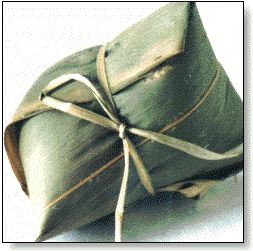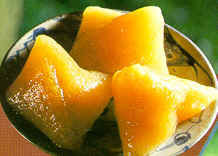Chinese Culture >> Chinese Food Articles >> Zongzi
Zongzi Introduction and History
The zongzi or rice dumpling is a traditional
Chinese food, to which the Mesoamerican
tamale is similar. In California where there are large Hispanics and Chinese
descent population, it is often called Chinese tamales on the menu. Many other Asian cultures also claim these rice dumplings
as traditional dishes. In Taiwanese, the meat version is "bah-tzang" whereas the
vegetable version is "tsai-tzang." Laotians and Vietnamese also have a similar
dish.
tamales on the menu. Many other Asian cultures also claim these rice dumplings
as traditional dishes. In Taiwanese, the meat version is "bah-tzang" whereas the
vegetable version is "tsai-tzang." Laotians and Vietnamese also have a similar
dish.
The origins of rice dumplings are traced to the legend of Qu Yuan, a well-loved poet who drowned himself in a river. To stop the fish from eating his body, people made rice dumplings and threw them into the river. Another version of the legend states that the dumplings were made to placate a dragon that lived in the river. Rice dumplings are made for the Dragon Boat Festival, which falls on the fifth day of the fifth month of the Chinese calendar
The fillings for the dumplings vary from region to region but the rice used is always glutinous rice (also called "sticky rice"). Depends on the region, the rice may be precooked or only soaked before using. Fillings may be sweet, such as mashed yellow beans, or savory, and may include pork, sausages, Chinese mushrooms, salted egg, and chestnuts. Some types of zongzi contain no filling at all, in which case they are usually eaten with sugar or syrup.
 The
rice dumpling is usually a pyramid of rice which encloses the filling and
wrapped in dried (or more rarely fresh) leaves. Bamboo leaves are perhaps the
most common, but lotus, maize, banana, canna, Alpinia zerumbet and Pandan
(Pandanus amaryllifolius) leaves are not unknown. Wrapping a dumpling neatly is
a skill which is passed down through families, as are the
Chinese recipes. Dumpling-making is usually a
family event with everyone helping out.
The
rice dumpling is usually a pyramid of rice which encloses the filling and
wrapped in dried (or more rarely fresh) leaves. Bamboo leaves are perhaps the
most common, but lotus, maize, banana, canna, Alpinia zerumbet and Pandan
(Pandanus amaryllifolius) leaves are not unknown. Wrapping a dumpling neatly is
a skill which is passed down through families, as are the
Chinese recipes. Dumpling-making is usually a
family event with everyone helping out.
The dumplings need to be steamed or boiled for several hours and one superstition says that dumplings will never cook if a pregnant woman enters the kitchen whilst they are being steamed. Dumplings may also be frozen for later consumption, but must be boiled instead of steamed when stored in this fashion. The salty zongzi is easy to cook when compared to the most difficult and hardest zongzi, the red bean (sweet). The red bean zongzi takes many hours to prepare. The red bean used to make the filling must be slowly cooked and simmered for at least 12 hours to turn the hard beans into a soft sweet paste. Any disruption of any kind in the cooking process will end up in a zongzi that is sub par.
